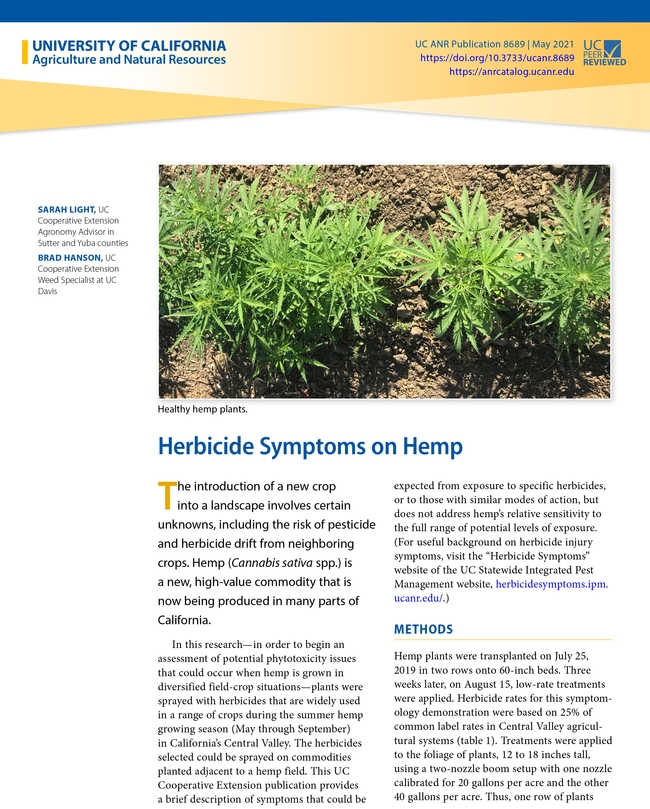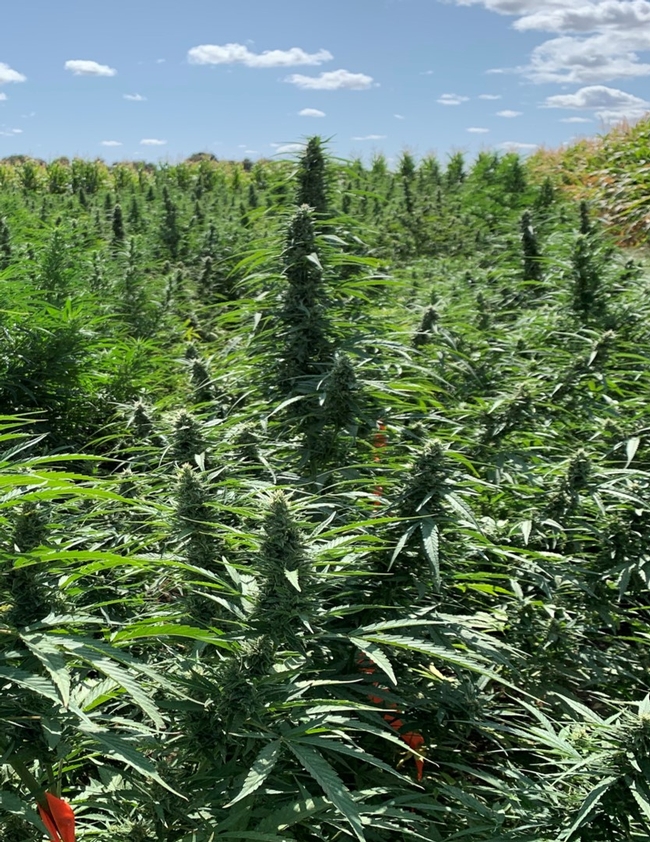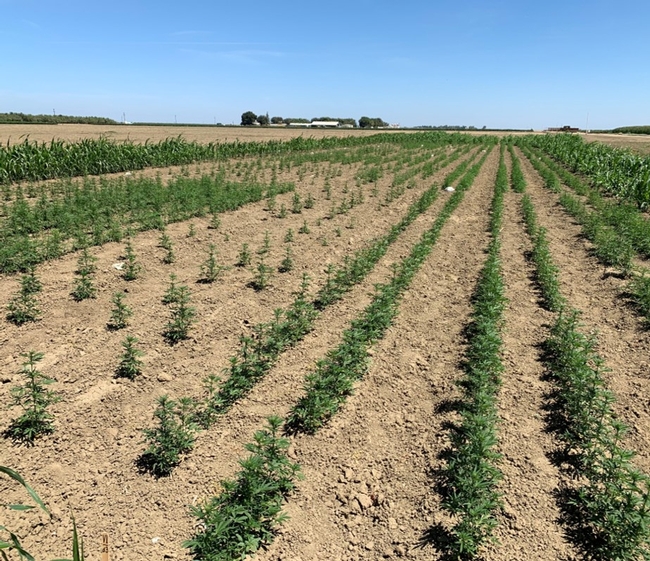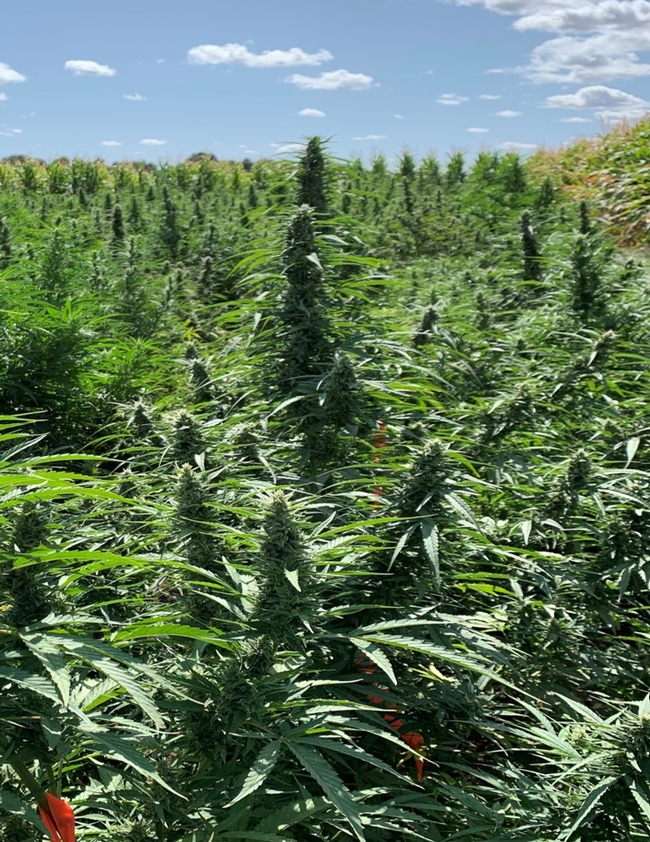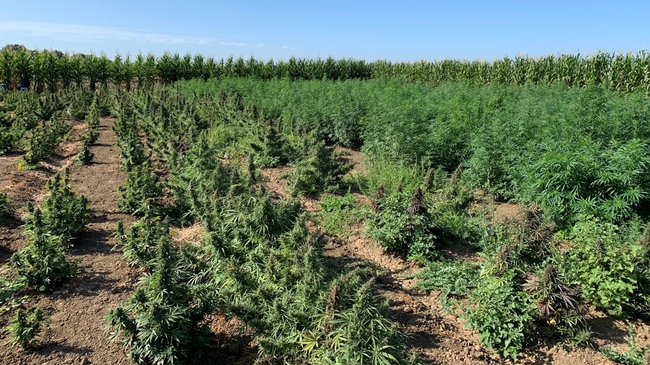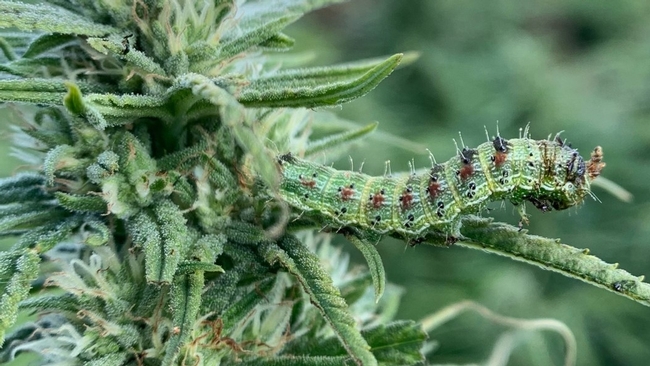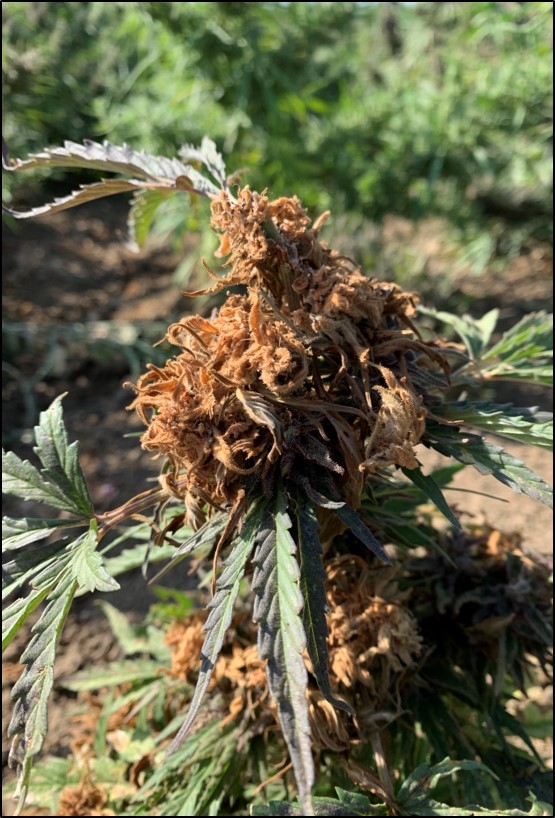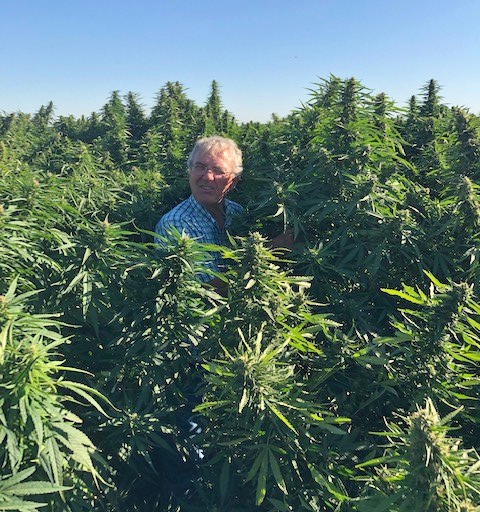Posts Tagged: hemp
New UC hemp publication shows potential symptoms caused by herbicide drift
Adding to a growing body of research about hemp cultivation, UC Cooperative Extension advisor Sarah Light and UCCE weed specialist Brad Hanson studied the symptoms of herbicide drift on this high-value commodity that is now being produced in many parts of California.
The results are available in a free downloadable publication in the UC Agriculture and Natural Resources catalog at https://anrcatalog.ucanr.edu/Details.aspx?itemNo=8689.
Hemp was legalized for production nationwide in the United States under the 2018 Farm Bill. Hemp has many uses – from textiles to food to biofuel – however is most sought-after for the chemical component cannabidiol (CBD), extracted for medicinal use.
Because of hemp's recent entry into the California crop complex, growers are hungry for information that will help them make irrigation, fertilization, pest management and other decisions.
“When they see unexpected damage on the plants, our growers, county agricultural commissioners and pest control advisers need to be able to determine whether a crop might have been subjected to herbicide drift from an adjacent field or orchard,” Light said. “We provided science-based evidence that can help guide their judgement.”
The scientists exposed hemp to low rates of 19 herbicides used in California. The rates and spray coverages are higher than would commonly occur in herbicide drift situations, because the scientists sought to compare typical symptoms from several herbicide modes of action on hemp. The publication contains 25 color photographs demonstrating the notable symptoms of different herbicides. In addition, detailed explanations about the symptoms observed over a two-week period following exposure are provided.
UC Agriculture and Natural Resources hemp research continues in 2020
Opportunities and challenges for industrial hemp production in California are being revealed in a series of UC Cooperative Extension research projects.
As a crop relatively new to California growers and researchers, there is still much to learn about variety choices, how varieties and crop responses differ across regions with different soils and climates, best practices for nutrient management, and pest and disease issues.
UCCE industrial hemp field research efforts began in 2019 after the previous year's Farm Bill declared the crop should no longer be considered a controlled substance, but rather an agricultural commodity. Hemp is valued for its fiber and edible seeds, however, in California, producing hemp for essential oils including medicinal cannabidiol (CBD) is thought to offer the best economic outlook.
2020 studies with Front Range Biosciences
UCCE is working with Lafayette, Colo.-based Front Range Biosciences to test 10 of the company's hemp varieties in Ventura County and the west side of Fresno County. In Fresno County, the trial is underway at the UC West Side Research and Extension Center (West Side REC) under the direction of UCCE specialist Bob Hutmacher. UC Cooperative Extension advisor Annemiek Schilder, the study leader in Ventura County, intended to conduct the trial at the UC Hansen Research and Extension Center in Santa Paula, but the Ventura County Board of Supervisors enacted an emergency ordinance in January prohibiting hemp fields within a half mile of residential areas and schools because of the odor.
“The odor can be quite strong,” Schilder said. “Once plants start flowering, some varieties smell skunky. But the crop is related to hops, and other varieties have a more pleasant hoppy smell. Weather conditions also play a role in odor complaints.”
The Ventura County industrial hemp trial was planted at an Oxnard farm where a hemp crop was already being grown.
The trial includes mostly photoperiod-sensitive cultivars, where the flowering response is triggered by shortening day lengths in mid- to late summer in this latitude. Varieties that do not require the shortening day length to flower are called auto-flower varieties.
“Industrial hemp cultivars grown for essential oils, such as CBD, can be photoperiod-sensitive or not sensitive,” Hutmacher said. “The auto-flower varieties have potential to be more versatile in some production systems, in that they could be planted at a broader range of times of year since they don't respond to day length.”
The studies include growth and yield evaluations, monitoring for pest or disease threats in the San Joaquin Valley and coastal California, and periodic plant sampling to monitor the changes in plant THC and CBD levels over time. THC (tetrahydrocannabinol) is the psychoactive compound found in greater concentrations in cannabis varieties grown for marijuana. Legal requirements for industrial hemp production for essential oils, fiber or seed mandate monitoring concentrations of THC. The crop may not exceed 0.3% at harvest or it must be destroyed.
2020 cooperative irrigation study with Oregon State University
In a new 2020 study led by Oregon State University, drip irrigation trials were set up in California at the UC West Side REC and the UC Davis campus in addition to three sites in Oregon. These studies were set up to determine water use of industrial hemp under irrigation regimes ranging from about 40% to 100% of estimated crop water requirements, with comparisons of responses observed across the five sites with different soils, climate and other environmental conditions.
The same four varieties (two auto-flower and two photoperiod-sensitive) are being grown in irrigation studies at each of the five sites. The California locations in these trials were both planted in mid-June. The two auto-flowering varieties were harvested in late August and early September. The researchers expect to harvest photoperiod-sensitive types in late September or October.
The total water use of the different hemp cultivars under the different irrigation regimes will be determined using applied water measurements and assessments of soil water use between planting and harvest for each cultivar.
Some of the irrigation treatments impose moderate to more severe deficit irrigation to help assess the crop responses to water stress. Deficit irrigation is a method of conserving water by applying less than what might be considered optimum for maintaining rapid growth.
“This plant appears to be quite tough under deficit irrigation,” Hutmacher said. “We need to learn more about benefits and drawbacks to stressing the plants.”
The auto-flower cultivars tested have used less water than the photoperiod-sensitive cultivars because they can be grown in a shorter season. In the San Joaquin Valley, auto-flower cultivars in these studies were ready for harvest in 75 to 90 days after seeding.
“Auto-flower varieties may have potential to be grown in the spring and harvested by early summer, or planted in late summer and harvested before winter. With a short-season crop, and with a decent water supply, farmers could consider double-cropping with such varieties, increasing profits,” Hutmacher said.
2019 and 2020 planting density studies
In cooperation with Kayagene Company in Salinas, Dan Putnam, UCCE alfalfa specialist at UC Davis, and Hutmacher have conducted studies in 2019 and 2020 with two auto-flower varieties to determine crop growth, yield and THC and CBD concentrations of planting densities ranging from about 7,500 plants per acre to 30,000 plants per acre. Since some of the auto-flower varieties are smaller and earlier maturing than many photoperiod-sensitive cultivars, data in these studies will help determine the tradeoff between higher densities needed to increase yields versus increases in the cost of growing more plants.
The studies also provided opportunities for the scientists to assess plant-to-plant variation and impacts of flower bud position on THC and CBD concentrations.
“We feel that when this type of basic sampling method data is collected across a range of cultivars differing in plant growth habit, it may help better inform both researchers and regulatory groups in decisions regarding how to monitor plant chemical composition,” Hutmacher said.
Hutmacher and Putnam are also working with scientists at Davis-based Arcadia Biosciences to refine sampling methods.
“There are a lot of challenges when it comes to estimating maturity with these varieties,” Putnam said. “Each variety will mature at different times and deciding when is the best time is a key decision.”
ANR in the news November 1-15
Are Blackouts Here to Stay? A Look into the Future
(E&E News) Anne C. Mulkern, Nov. 15
…Throughout the United States, between roughly 2000 and 2010, about 75% of homes that burned in wildfires were located in the WUI, said Van Butsic, a land use specialist at the University of California, Berkeley. The rest was mostly in rural areas, with about 2% in cities.
People go back after they lose homes, Butsic said. He surveyed the 28 largest fires in California from about 1975 to 2005, and through aerial photos tracked what was rebuilt. About 90% of destroyed homes were rebuilt within a decade, he found. New homes also filled in large tracts of undeveloped land in formerly burned areas.
https://www.scientificamerican.com/article/are-blackouts-here-to-stay-a-look-into-the-future/
Climate Considerations for Processing Tomatoes
(AgNet West) Nov. 15
Research models show that increases in overall temperatures in California will have a direct effect on how some crops are going to be produced in the future. In one study looking at processing tomato production in the Central Valley, researchers found that changing temperatures will likely have a noticeable impact on the timing of the growing season.
“We looked at the data all the way starting from 1950, into the future by 2030-2040 and see how the time of maturity is changing,” said Tapan Pathak, UC Specialist in Climate Adaptation in Agriculture. “What we saw is, in general the time from emergence to maturity, the timeframe for processing tomatoes in that region, is going to shrink down almost by two to three weeks.”
http://agnetwest.com/climate-considerations-processing-tomatoes
What's Growing On: American rose trials test sustainability
(Stockton Record) Marcy Sousa, Nov. 15
Did you know San Joaquin County Master Gardeners have been part of a National Rose Trial since 2018? The trial is part of the American Rose Trials for Sustainability (A.R.T.S.) program that has trial sites across the United States. It was initiated in 2012 by individuals representing multiple rose stakeholder groups, including: industry, the scientific community and public gardens. There are only two Mediterranean climate trial locations and both are in California. The trials at the Fullerton Arboretum started in 2019 and the UC Cooperative Extension office in San Joaquin County began in 2018.
…Our Environmental Horticulture Advisor, Karrie Reid, has been managing and overseeing the trial since 2018. Our roses were planted in unused turf areas that were converted to the trial grounds. One of the selling features of converting the turf sections was the calculated water savings: 3,656 square feet of turf used 103,000 gallons of water, while 60 roses in the same area on drip use 6,175 gallons, a 94 percent savings. Trial sites are covered with a 3-inch layer of wood mulch.
Report: California ag is a major economic driver for the state
(Agri-Pulse West) Brad Hooker, Nov. 13
A new report by the University of California Division of Agriculture and Natural Resources (ANR) adds new dimensions to the “massive economic juggernaut” of the California agricultural industry. The findings reveal that agriculture contributed more than $263 billion to the economy in 2018 through direct sales and employed more than 1.2 million people, while benefiting urban and rural regions alike.
The report examines the entire “working landscape,” which also includes fishing, forestry, mining, outdoor recreation and renewable energy, in addition to agricultural distribution, production, processing and support. Together, the sectors represent $333 billion in sales, 1.5 million jobs and 6.4% of the total California economy, outranking the healthcare, real estate, construction and retail sectors. Agriculture accounted for 85% of the working landscape businesses and 79% of the sales income. According to ANR Vice President Glenda Humiston, the working landscape likely surpasses the finance sector as well.
UCCE Addressing Watergrass Issues in California Rice Fields
(AgNet West) Brian German, Nov. 13
Researchers from UC Cooperative Extension (UCCE) are looking closely at the watergrass issues in California rice fields to get a better understanding of the problem. Watergrass has historically been a fairly common weed species that growers face, however in recent years the issue has been compounded by a number of factors. Several watergrass species have demonstrated resistance to the materials available and it appears that one or two new species may have emerged.
“In the past few years watergrass is becoming more and more of a problem, whether it's the ones that we know that we have or these possible new species,” said Whitney Brim-DeForest, UC Rice Farm Advisor serving Sutter, Yuba, Placer, and Sacramento Counties. “It's just becoming more difficult to control with the herbicides that we have.”
http://agnetwest.com/ucce-watergrass-issues-california-rice-fields/
Experts Warn Of Surge In Sudden Oak Death Infections In North Bay
(KPIX) Wilson Walker, Nov. 12
“And then, of course, these limbs that have just fallen off,” said Kerry Wininger of UC Cooperative Extension as he stood beneath a dying tree in Sonoma County's Fairfield Osborn Preserve. “And big patches will come out at once.”
Wininger is with the UC team working to measure the problem, and the numbers are up dramatically. She oversees a yearly survey conducted by volunteer citizen scientists.
…“For Sonoma County in general, Sudden Oak Death numbers look about double where they were last year,” said Wininger. “So it's actually increasing at a rate a little bit faster than we would expect.”
Shelter exercise at the fairgrounds
(Appeal Democrat) Ruby Larson, Nov. 12
Some Glenn County agencies came together at the Glenn County Fairgrounds to participate in a shelter management training exercise last week.
…Travis said agencies that participated included Health and Human Services, sheriff's office, animal control, UC Cooperative Extension and North Valley Animal Disaster Group.
California's Wildfire Policy Totally Backfired. Native Communities Know How to Fix It.
(Mother Jones) Delilah Friedler, Nov. 11
…“We aren't anywhere near bringing fire back at the scale we need to,” says Lenya Quinn-Davidson, a fire advisor with the University of California Cooperative Extension who helped lead that burn. “It's important to push forward with a grassroots model that empowers people to do the work, instead of having bottlenecks with the agency that's in charge.”
The Humboldt County Prescribed Burn Association, which Quinn-Davidson leads, was the first organization of its kind in the West when it started in 2018, and has already inspired similar groups to start up in northern California's Plumas, Nevada, Sonoma, and Mendocino counties. These groups bring landowners and neighbors together to provide the manpower that controlled burns require. Quinn-Davidson says she's hosted 25 lecture and field-based workshops in the past year to increase people's comfort with prescribed fire, and in the past two years, she's led 20 burns on private lands.
Zediker honored as CattleWoman of the year
(Siskiyou Daily News) Nov. 10
Siskiyou County native Jacki Zediker was honored on Saturday, Oct. 26 as the 2019 Siskiyou County CattleWoman of the Year during the annual Cattlemen and CattleWomen's dinner in Yreka.
… Zediker has been the 4-H Youth Development Program Representative with the UC Cooperative Extension in Siskiyou County for more than 20 years, and has served as the regional coordinator for the North State counties in recent years, the CattleWomen said.
- https://www.siskiyoudaily.com/news/20191110/zediker-honored-as-cattlewoman-of-year
- https://www.taftmidwaydriller.com/news/20191110/zediker-honored-as-cattlewoman-of-year
Insect entrepreneurs use almond hulls as feed source for bugs
(Daily Democrat) Ching Lee, Nov. 8
…Maurice Pitesky, a UC Cooperative Extension veterinarian and specialist in poultry health and food-safety epidemiology, conducted an experiment two years ago on pastured layers, feeding up to 20% of the birds' diet with soldier fly larvae “with no change in welfare, egg quality, mortality.” The larvae feed provides methionine, an essential amino acid for poultry, and has “significant potential” to increase poultry production while freeing “more corn and soy calories for humans,” he said, though he warned of two caveats: economics and consistency of manufacturing the feed.
http://www.dailydemocrat.com/insect-entrepreneurs-use-almond-hulls-as-feed-source-for-bugs
Paradise rebuilds, but fire safety sometimes takes a back seat to economic realities
(LA Times) Laura Newberry, Nov. 8
…“Having this zone right next to a building is pretty important,” said Steve Quarles, a senior scientist with the Institute for Business & Home Safety who studied homes in Paradise after the fire. “No matter what the homeowner does in terms of vegetation management on the property, embers can blow over and ignite that woodpile next to the house.”
For the Record (LA Times) Nov. 12
Camp fire: In the Nov. 8 Section A, an article looking at the changes in Paradise, Calif., since the Camp fire a year earlier misidentified Steve Quarles as a senior scientist with the Institute for Business & Home Safety. Quarles has retired from that post and now serves as a UC Cooperative Extension advisor emeritus.
https://www.latimes.com/california/story/2019-11-08/rebuilding-paradise-one-year-after-camp-fire
Sudden oak death rebounds in Sonoma County, spreads in California
(Press Democrat) Guy Kovner, Nov. 8
… Matteo Garbelotto, director of the forest pathology and mycology laboratory at UC Berkeley, said discovery of the two infected tanoaks in Del Norte County was a signature finding of this year's sudden oak death survey, known as the SOD Blitz, organized by his lab since 2008.
“It's a good thing that we detected it because the sooner we know, the more options available to minimize the impact of the disease,” he said.
https://www.pressdemocrat.com/news/10262894-181/sudden-oak-death-rebounds-in
The 2050 challenge
(Iowa Farm Bureau) Teresa Bjork, Nov. 8
…Dr. Frank Mitloehner, an air quality extension specialist at the University of California-Davis, said American consumers don't realize that modern agriculture practices have helped increase our food supply while decreasing potential greenhouse gas emissions.
“It's time for us to explain what we do in agriculture in a way that the public understands,” Mitloehner said.
https://www.iowafarmbureau.com/Article/The-2050-challenge
Sudden oak death spreading fast, California's coastal forests facing devastation
(San Francisco Chronicle) Peter Fimrite, Nov. 7
…The rate of trees infected almost doubled in 2019 — from 3.5% to 5.9% — and was 10 times higher in some places compared with the 2018 survey, said Matteo Garbelotto, the director of the UC Berkeley Forest Pathology and Mycology Laboratory, which tested leaf samples taken by 422 volunteers.
...“There was a significant increase in infection rates over last year, but that's not totally surprising because we had a lot more rainfall,” Garbelotto said. “But it was a surprise to see them all at once. It's telling us we are entering a different phase of the disease, where the organism isn't really establishing itself in new areas, but is showing itself more when weather conditions are favorable.”
We mapped every wine country fire. They're larger and more destructive than ever
(Los Angeles Times) Priya Krishnakumar, Nov. 7
…Why is this happening? Scientists point to rising temperatures and the effects of Santa Ana and Diablo winds on increasingly dry terrain.
“In a way, climate change is priming the landscape to ignitions,” said Max Moritz, a wildfire specialist at UC Santa Barbara.
…Experts say many of the losses are due to increased development, as more and more homes have been built in areas prone to fire.
“The homes are the fuels,” Moritz said. “We see these burned neighborhoods where there are still shrubs and trees, and it's clear the homes propogated the fire.”
https://www.latimes.com/projects/wine-country-fires-california-sonoma-napa/
Water users making case in bankruptcy court; Cal Fire says dry canal poses fire hazards
(Chico News & Review) Ashiah Scharaga, Nov. 7
…Gosselin said the county is scheduling another meeting with water users for January. While “we cannot get in the middle and restore water to the Middle Miocene,” he said, it is exploring a project with Del Oro to extend water service on Pentz Road, which would help some of the folks who have been served by the canal. The UC Cooperative Extension is also close to completing an economic study related to the loss of the Miocene on water users, and Gosselin intends to seek grants and other funding for water supply reliability projects.
https://www.newsreview.com/chico/missing-in-action/content?oid=29213484
Farm City Newsday Thursday, 11-07-19
(AgNet West) Danielle Leal
Get the latest agriculture news in today's Farm City Newsday, hosted by Danielle Leal. Today's show is filled with stories covering the current disconnect in state and federal hemp regulations, California's working landscape sector providing significant economic value and details on the Almond Board of California's conference silent auction that benefits FFA students and how you can help. Tune in to the show for these news stories, recipes, features and more.
http://agnetwest.com/farm-city-newsday-thursday-11-07-19/
California working landscapes generate $333 billion in sales and 1.5 million jobs
(News release) Pam Kan-Rice
- https://plantingseedsblog.cdfa.ca.gov/wordpress/?p=19581
- https://yubanet.com/california/californias-working-landscape-generates-333-billion-in-sales-1-5-million-jobs
- https://cvbtcom.ipower.com/californias-working-landscape-generates-333-billion-in-sales/
- https://fruitgrowersnews.com/news/study-californias-working-landscape-supports-more-than-1-5-million-jobs/
Power shutoffs leave some farmers feeling ‘helpless'
(Ag Alert) Ching Lee, Nov. 6
… "If they've lost cooler capacity or the ability to wash product, not only are they taking a hit on the expense side, but they have less to sell," Placer County sheep rancher Dan Macon said. "That's kind of a double whammy for a number of folks."
… Wineries also are running into this problem, said Anita Oberholster, an enology specialist for University of California Cooperative Extension. Those operating on generators are running low on fuel and can't get it to their wineries, which need power not only to process fruit but to control temperature during the fermentation process. Because yeast can generate a significant amount of heat during fermentation, an inability to control temperature could affect the quality of the wine, she said.
… "People are making the investments they need to make, but it's stuff that's outside the normal course of business, and I think there'll be some financial impacts from that in terms of this season's profitability," he said.
As a UCCE livestock and natural resources advisor, Macon said the outage has prompted him to start sending a survey to farmers in an effort "to catalog resources that are out there and available for sharing in situations like this," whether it's generators, water-hauling capacity or, in the case of fire, the ability to load livestock quickly and safely.
http://www.agalert.com/story/?id=13411
Spring rains likely caused waterlogging of walnut trees
(Farm Press) Logan Hawkes, Nov. 6
…Luke Milliron, UCCE Farm Advisor in Butte, Glenn, and Tehama Counties and Janine Hasey, UCCE Farm Advisor Emeritus, also addressed the topic in a recent blog post.
“Plant roots need to breathe,” they wrote. “This process of respiration is critical to energy production in roots. Saturated surface soil moisture levels restrict root access to atmospheric oxygen, limiting the energy production of respiration and eventually resulting in root asphyxiation (death).”
https://www.farmprogress.com/tree-nuts/spring-rains-likely-caused-waterlogging-walnut-trees
California agriculture in 2050 – where we are headed and why
(CDFA blog) Nov. 5
At its monthly meeting today, the California State Board of Food and Agriculture heard a cautiously optimistic appraisal of agriculture's future through 2050 from economist Dr. Daniel Sumner, director of the Agricultural Issues Center at UC Davis. Dr. Sumner believes that net farm income will continue to grow, even though it may experience ups and downs, and that growth specifics will hinge on the management of five key cost factors:
https://plantingseedsblog.cdfa.ca.gov/wordpress/?p=19531
Beckstoffer Vineyards, in Partnership with University of California, Davis and Duarte Nursery, Launches Groundbreaking Clonal and Rootstock Trial Addressing Climate Change and Improved Grape Quality in Cabernet Sauvignon
(Wine Industry Advisor) Nov. 5
Andy Beckstoffer, perhaps the most recognized California grower of wine grapes, announced that Beckstoffer Vineyards, in partnership with University of California, Davis and Duarte Nursery, has launched a groundbreaking trial addressing climate change and improved grape quality for Cabernet Sauvignon at Beckstoffer's Amber Knolls Vineyard in the Red Hills of Lake County. University of California, Davis called the trial “the mother of Cabernet research trials.”
Study: California's working landscape supports more than 1.5 million jobs
(Fruit Grower News) Nov. 5
California's working landscape and the industries associated with agriculture and natural resources contribute significantly to the state's economy, according to a new study by the California Community Colleges Centers of Excellence for Labor Market Research, California Economic Summit and the University of California's Division of Agriculture and Natural Resources.
UC scientists seek innovative uses of ag waste
(Farm Press) Chris Brunner, Nov. 5
…Historically these waste materials have been used as a rich source of compost. However, scientists at UC Cooperative Extension are researching innovative uses for this material.
Dr. Pramod Pandey, a faculty member and Cooperative Extension specialist at the UC Davis School of Veterinary Medicine, focuses on better ways to manage waste material for both large and small farms. Dr. Pandey researches how to convert the organic matter in manure and other waste materials into a renewable energy source that can be used to power our state.
https://www.farmprogress.com/dairy/uc-scientists-seek-innovative-uses-ag-waste
Shifting Winds in Fire Management
(Noozhawk) Harrison Tasoff, Nov. 4
…“We are mixing up the problem of forest and fuel management with the problem of wildland-urban interface fires,” said Max Moritz, an adjunct professor at UC Santa Barbara's Bren School of Environmental Management and a statewide Cooperative Extension wildfire specialist.
https://www.noozhawk.com/article/shifting_winds_in_fire_management
Early UC hemp research already yielding results
(Farm Press) Jeannette Warnert, Nov. 4
For the first time ever, UC Agriculture and Natural Resources (UC ANR) researchers harvested an industrial hemp crop at one of its nine research and extension centers this fall.
“It's an interesting crop,” said UC Cooperative Extension specialist Bob Hutmacher. “There is a tremendous amount of research that can be done to understand its growth and best cultural practices, optimal planting dates either by seed or transplants, irrigation and fertilization management, and, particularly, to address pest and disease management.”
https://www.farmprogress.com/hemp/early-uc-hemp-research-already-yielding-results
Day of the Dead – More Than a Colorful Sugar Skull, UC ANR Says
(Sierra Sun Times) Ricardo A. Vela, Nov. 2
- Many of us in the US have seen or heard something about the Mexican celebration El Dia de Los Muertos (Day of the Dead), whether it's a reference in a horror movie or a community fair where children get their faces painted as colorful skulls. For many, that is the extent of their knowledge of this millenary, radiant and vibrant Mexican celebration.
Early UC Hemp Research Already Yielding Results
(CalAg Today), Nov. 2
For the first time ever, UC Agriculture and Natural Resources (UC ANR) researchers harvested an industrial hemp crop at one of its nine research and extension centers this fall.
"It's an interesting crop," said UC Cooperative Extension specialist Bob Hutmacher. "We don't have a lot of experience in UC ANR with hemp at this time. There is a tremendous amount of research that can be done to understand its growth and best cultural practices, optimal planting dates either by seed or transplants, irrigation and fertilization management, and, particularly, to address pest and disease management."
https://californiaagtoday.com/early-uc-hemp-research-already-yielding-results/
In Woodlake, One Motivated Couple And A Mile-Long Garden Inspire Children And Flowers To Flourish
(KVPR) Alice Daniel, Nov. 1
…And that's the point, right there. It's why two life-long Woodlake residents, Olga and Manuel Jimenez started the garden 16 years. Ago. It's named for the lake next to it. Taking care of the garden builds character, Manuel says. And strong work skills, and relationships.
… It sits between a lake and a road on land the city bought with a rails to trails grant, so it's far longer than it is wide. Manuel's retired now but he designed it when he was still a UC small farm advisor.
California Fire Danger Continues to Worsen, Experts Say
(Wall St J) Jim Carlton, Nov. 1
…“There's no simple problem and no one simple answer,” said Max Moritz, statewide fire specialist based at the University of California, Santa Barbara.
https://www.wsj.com/articles/california-fire-danger-continues-to-worsen-experts-say-11572623148
On the Hunt: Study Seeks Answers on Wildlife Exposure to Lethal Rat Poison
(CSU Fullerton) Nov. 1
…Under the mentorship of Paul Stapp, professor of biological science, and in collaboration with scientist Niamh Quinn, a human-wildlife interactions advisor with the University of California Cooperative Extension in Irvine, Burke is studying how native wildlife is exposed to rodenticides. Burke has been working on the research over the past two years for his thesis project.
…For his project, Burke set up bait stations — tamper-proof black boxes — at 90 sites in Orange County — in the backyards of homeowners who participate in the Master Gardeners of Orange County program, and grow large amounts of fruits and vegetables, which attract animals, including rats.
http://news.fullerton.edu/2019fa/rat-poison-research.aspx
As fires rage, pressure mounts to train California's next generation of forest stewards
(Edsource) Sydney Johnson, Nov. 1
… Blake Schmidt, a math teacher at Ross Middle School in Marin County, decided to take his students to Forestry Challenge after participating in a free [UC ANR] statewide program for California teachers called the Forestry Institute for Teachers.
Early UC hemp research already yielding results
For the first time ever, UC Agriculture and Natural Resources (UC ANR) researchers harvested an industrial hemp crop at one of its nine research and extension centers this fall.
“It's an interesting crop,” said UC Cooperative Extension specialist Bob Hutmacher. “There is a tremendous amount of research that can be done to understand its growth and best cultural practices, optimal planting dates either by seed or transplants, irrigation and fertilization management, and, particularly, to address pest and disease management.”
The research project is part of a two-location study, one at the UC West Side Research and Extension Center (WSREC) in Five Points, in western Fresno County, and an identical companion study at the UC Davis farm headed by UC Cooperative Extension specialist Dan Putnam and UC Davis professor and plant breeder Charles Brummer. These initial studies included a planting density by variety trial and a breeding observation block representing a wide range of genetics. The research was launched mid-summer this year after the 2018 Farm Bill declared that hemp should no longer be considered a controlled substance, but rather an agricultural commodity.
Industrial hemp can be produced for grain and fiber, however, many growers currently consider the most profitable component of the crop to be cannabidiol, or CBD, and related compounds. CBD is valued for its purported health benefits. It is said to reduce inflammation, pain, nausea, depression and anxiety, among other conditions.
Hutmacher said he and colleagues around the state are interested in learning about industrial hemp production opportunities, and feel there is a place for UC ANR research to support the fledgling industry. Already, there are some observations coming out of these small trials.
“Some people believe that hemp is a pest- and disease-free plant. That's not what we found,” Hutmacher said. “In the absence of suitable measures for control, corn ear worms seemed to thrive in hemp, and did an astounding amount of damage to cultivars in our small plots.”
The scientists were forced to use a pesticide to control the pest and reduce damage to developing buds. The hemp produced in the trial will be destroyed after harvest data has been collected. The experience with corn ear worm and other pest issues demonstrate that pest control will require significant study, particularly if a goal is to produce the crop organically.
“Markets for some industrial hemp products may require low pesticide residues. If hemp is produced organically, some preliminary observations this year suggest farmers will have to put a big effort into pest and disease control,” he said.
Plant breeding can be another area of UC research. Hemp's natural genetic variations produce plants that vary widely in growth habit, size, response to day length, and time to maturity. There are hemp cultivars that mature when the plant is 18 inches tall and others that shoot up 12 feet high at maturity. Hemp grown for CBD production from seed or as transplants can vary greatly in size and other characteristics, such as amount of branching and the number of flower structures per plant. Multiple plant and production system factors also will influence options for mechanical versus hand harvesting.
Another breeding concern for growers is producing a crop with economic levels of CBD or other compounds of commercial interest, while staying within regulatory limits for THC (tetrahydrocannabinol), the psychoactive compound found in marijuana, a related plant. According to the California Department of Food and Agriculture, an industrial hemp crop grown in the state may have no more than 0.3% THC when plant samples are analyzed.
“This will be a challenge for growers. You don't want to risk too high a THC level,” Hutmacher said. “Farmers must test to make sure THC is at a level to meet regulations. If it's too high, CDFA regulations would require the crop be destroyed.”
Working with UC breeders, integrated pest management scientists, agronomists, irrigation specialists and agricultural engineers, there should be good opportunities to finesse hemp production at UC ANR's network of research and extension center system across California.
Research center locations stretch from Holtville, in the low desert at the California-Mexico border, to Tulelake, just south of the Oregon border. Other centers ideal to answer hemp research questions include the UC Davis campus, the Hopland REC in Mendocino County, the Hansen REC in Ventura County, and the South Coast REC in Orange County.
UC ANR plans to expand its hemp research in 2020. For more information, contact Bob Hutmacher at (559) 260-8957 or rbhutmacher@ucdavis.edu.
The Buzz About Honey Bees and Marijuana
Extension apiculturist emeritus Eric Mussen of the UC Davis Department of Entomology and Nematology, "retired" in June of 2014 after 38 years of...
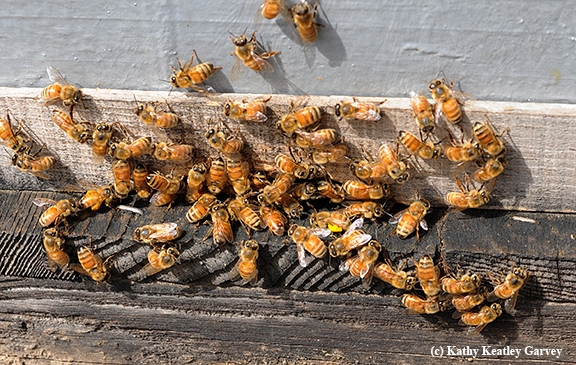
Honey bees laden with pollen returning to their colony. (Photo by Kathy Keatley Garvey)



